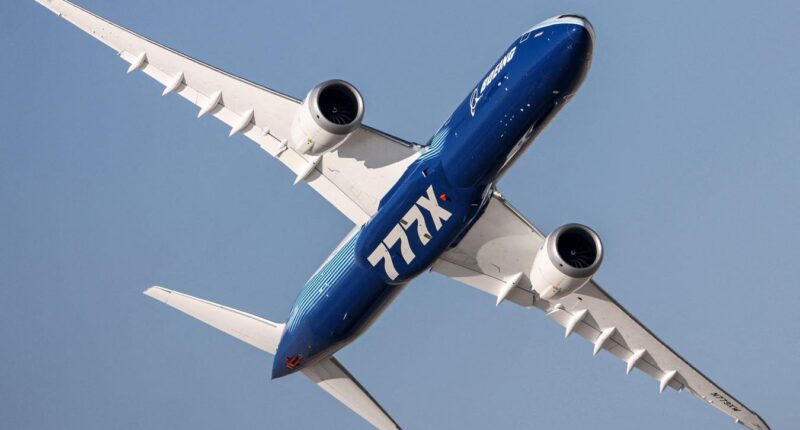Share this @internewscast.com
A Boeing 777X aircraft performs a demonstration flight at the 2021 Dubai Airshow in the Gulf emirate on November 14, 2021. (Photo by Giuseppe CACACE / AFP) (Photo by GIUSEPPE CACACE/AFP via Getty Images)
AFP via Getty Images
Boeing’s next-generation widebody aircraft program—the 777X—is delayed once again. The jet program launched in 2013 with a planned 2020 debut, but is now not expected to carry its first paying passengers until 2027.
The slip reflects the complexities of designing and certifying a revolutionary new plane. The 777X introduces several innovations, including unique folding wingtips, gigantic GE9X engines that are larger than the fuselage of a 737, and a reengineered cabin architecture that will free airlines to be creative and delight passengers.
A Mountain Of Work Ahead To Certify The 777X
WASHINGTON, DC – APRIL 2: Kelly Ortberg, President and Chief Executive Officer of The Boeing Company, testifies during a Senate Committee on Commerce, Science, and Transportation hearing on Boeing, in Washington, DC on April 2, 2025. (Photo by Nathan Posner/Anadolu via Getty Images)
Anadolu via Getty Images
Boeing’s latest confirmation that it will push out deliveries to 2027 was not surprising. At the Morgan Stanley Laguna Conference in September, Boeing Chief Executive Kelly Ortberg acknowledged the company is behind schedule due to a “mountain of work” still to be completed on the 777X program.
“The good news is we’ve got five aircraft now into the test program. We’re flying a lot of sorties, and there are no new technical issues on the airplane or the engine,” he said. “Both the airplane and the engine are really performing quite well.” But, he added, “we are falling behind on the certification.”
The main challenge for Boeing is obtaining Type Inspection Authorization, which is clearance from the FAA to perform the various tests required. “We still don’t have authorization from the FAA for a good portion of the certification program,” Ortberg said. “We’re working through that right now with the FAA. But, we’re clearly behind our plan in getting the certification done.”
Describing the process as “way too slow,” Ortberg said Boeing would “work with the FAA in swinging the pendulum back and making that a process that will work. I can’t imagine that we can do a new airplane without having that process refined.”
The delay has had consequences for Boeing. “Even a minor schedule delay on the 777 program has a pretty big financial impact because we’re in a reach-forward loss situation,” Ortberg said. In its Q4 2024 financials, Boeing reported reach-forward losses of $4.08 billion for the 777X and 767 programs combined. “We’re looking at that real hard,” Ortberg added.
Airlines Still Look Forward To The 777X
The exterior of a Boeing 777X flight test aircraft at the Everett Delivery Center on June 26, 2024 in Everett, Washington. The 777X, Boeing’s latest incarnation of the popular 777 family, has received more than 500 orders, although it has not yet entered commercial service. Boeing had originally planned for the jet to enter service in January 2020. But the timeframe has been pushed back to 2025 due to certification delays. The jet still must be certified by the US Federal Aviation Administration. (Photo by Jennifer Buchanan / POOL / AFP) (Photo by JENNIFER BUCHANAN/POOL/AFP via Getty Images)
POOL/AFP via Getty Images
Despite the setbacks, demand for the 777X has remained strong. During the Laguna Conference, Ortberg described demand as “fantastic.” Boeing has earned over 550 orders for the next-generation plane.
“It’s going to be a great airplane,” Ortberg said. “We’ve just got to get ourselves through the certification program, and the mound of work is still in front of us.”
Airlines eagerly anticipate the 777X because of what it promises: a larger cabin, lower fuel burn, and a more extended range than its predecessors. With its folding composite wings and high-bypass GE9X engines, Boeing claims the jet will reduce fuel burn and emissions by approximately 10 percent compared to the 777-300ER, which remains the mainstay of many long-haul fleets.
For airlines squeezed by fuel costs and environmental pressure, those gains are significant. The 777-9 will carry more than 400 passengers, offering airlines an opportunity to consolidate routes, while the smaller 777-8 will serve ultra-long-range missions.
While the aircraft’s customers remain eager to add the 777X to their fleet mix, the long delays have forced some adjustments to fleet plans, including introducing keeping older aircraft in service longer by refurbishing interiors.
Still, had the 777X been completed by 2020, as initially planned, its customers might have struggled to introduce such a large plane at the height of the COVID-19 global shutdown. The main issue for airlines has been having to wait to introduce the new plane to support higher demand as passengers returned.
The 777X’s Largest Customer
BERLIN, GERMANY – MARCH 4: The current President of Airline Emirates Sir Tim Clark attends a Panel discussion with TV-Moderator Ali Aslan (unseen) at the German Council for Foreign Relations (DGAP) headquarter on March 4, 2015 in Berlin, Germany. Questions about the future of the aerospace industry and the success of the Emirates were topics during the discussion. (Photo by Christian Marquardt/Getty Images)
Getty Images
Dubai-based Emirates is the largest customer of the 777X, having ordered 205 units in total, comprising 170 of the 777-9 variant and 35 of the 777-8 variant.
Emirates President Tim Clark has been vocal about his impatience with the program’s delays in the past. However, this June, during the International Air Transport Association Annual General Meeting, Clark indicated that he was “cautiously optimistic” of getting the first 777-9s in 2027.
“I can see a high degree of determination for getting the job done to make sure all the things that have been called out by Emirates and others have been addressed,” he said.
With the latest entry to service date, Emirates may need to wait a bit longer. Lufthansa is the launch customer for the type. The German flagship has placed 20 firm orders for 777-9s and ordered seven 777X freighters.
For Passengers, The 777X Is Well Worth The Wait
06 June 2023, Hamburg: A look inside the mock-up of a Boeing 777X cabin at the booth of aircraft manufacturer Boeing at the Aircraft Interiors Expo (AIX) in the exhibition halls. The show is an international exhibition centered around aircraft interiors and will be held June 6-8, 2023. Photo: Marcus Brandt/dpa (Photo by Marcus Brandt/picture alliance via Getty Images)
dpa/picture alliance via Getty Images
Before acknowledging the revised program timeline to 2027, Boeing shared a glimpse of what’s to come in a YouTube video tour of the 777X’s interior, inviting viewers to “step inside the future of flying.”
The aircraft will feature larger windows, letting in more natural light, and a cabin architecture that feels spacious and modern. The 777X cabin is 4” wider, which means seats in economy class can be roomier, even in a 10-across configuration. Airlines will no doubt get creative in their cabin design, offering tantalizing options, especially for premium flyers.
Emirates has previously stated that it intends to feature its “Game Changer” first-class suite on the 777X, which it first introduced on its 777-300ERs in 2018. The lavish suite features floor-to-ceiling sliding doors and “up to 40 square feet of personal space,” according to Emirates. They are in a 1-1-1 configuration, and Emirates provided the middle suite passenger with a view by installing virtual windows that project images from outside recorded by cameras installed on the aircraft and transmitted in real-time.
Since the first “Game Changer” will be nearly ten years old by the time Emirates finally receives its 777X, the airline might introduce design updates.
The 777X has become a waiting game for airlines, passengers and for Boeing itself. But, if the next-generation widebody delivers on its promises—greater efficiency, capacity, and enhanced passenger comfort—it will more than justify the patience.






